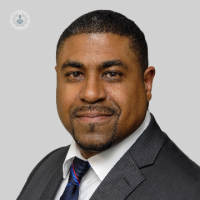A shoulder to lean on: recovering from a shoulder fracture
Escrito por:The recovery stage from a shoulder fracture can be a painful and drawn-out process. However, it doesn’t need to be this way; with encouragement and the right medical assistance, healing can be effective.
Here to provide expert advice regarding shoulder fracture rehabilitation is leading consultant trauma and orthopaedic surgeon Mr Charles Jeremy Corbin.

Is surgery always required for shoulder fractures?
That's obviously a no. The whole point of management of shoulder fractures is to try to get the fracture to heal in a good enough position, so that you can prevent stiffness, mobilise and use the shoulder as you would have done before the injury.
Whether or not surgery's needed will depend on how serious or how bad the fracture is. It also depends on a number of factors. Essentially, if the fracture isn't very bad and there isn't significant displacement of the bones, and everything looks stable enough to start moving gently early, then surgery isn't needed.
Surgery will only be needed if you need to stabilise the fracture so it allows early mobilisation. Surgery depends on which bones is fractured, which part of the bone is fractured, how close it is to the joint, the amount of displacement of the fractured fragments, for example if everything is broken but still maintains the same shape of the shoulder, then surgery is likely not needed. But if it's broken and these bits are in separate places, quite distant from each other, then surgery is maybe needed to bring them all back together in the shape of the bone.
Also, if a dislocation is involved, surgery may be needed to reduce that dislocation of the shoulder back into the joint so that the blood supply isn't disrupted in order to allow healing. Those are the main reasons. So, surgery isn't always needed, but it may be required to allow you to mobilise safely early.
If surgery is required, how long is the recovery process and what stages does it have?
If it is required, you'll then have the immediate post-operative stage where we can get the soft tissue to settle down, make sure there's no infection, and start to gently mobilise. That is the initial stage.
Then I like to think of it in three stages; you'll have the stage where you'll start to move the shoulder passively and then you can move it actively. Now, if you've had surgery, you would have stabilised the fracture hopefully, or replaced a part that may not have healed, and in such case, you can shorten the first two stages, these initial stages, as much as possible so you can then get active motion going early.
I think of three stages in terms of:
- Early post-operative phase;
- The active range of movement phase;
- And then the advanced phase where you're going for full range of movement, stretches and strengthening of the shoulder.
If surgery isn't required, how long is the recovery process and what stages does it have?
If surgery isn't required, those three phases seem to be more developed. You have the early phase where you have a passive range of movement where you want to protect the fracture while you gently try to get the muscles moving and maintain the joint. You're actually passively moving it, so in other words you don't want the fracture to be pulled apart by the muscles and so they gently move the shoulder around.
Some people recommend pendular exercises, where you allow the gravity to work to straighten the arm and make sure the elbow doesn't become stiff, make sure the wrist doesn't become stiff and the fingers, so you're gently moving the other joints to ensure they don't become stiff while still protecting the fracture position in the shoulder. That takes about four to six weeks.
Following that, you'll have your active range of movement exercises where you're actually using the muscles of the shoulder to get the arm moving. That's usually another six weeks where you're actively using the range of movement and trying to prevent stiffness. You're slowly towards the end of that phase building up the strength in the shoulder.
Then you have the other phase, the last phase, which is the phase where you're actively stretching the shoulder out to make sure there's no stiffness. As I said, the whole point of dealing with the injury to the shoulder is to prevent stiffness which is a very real possibility following injuries such as shoulder fractures. The whole push is to mobilise the shoulder in order to prevent stiffness while protecting the fracture. Surgery stabilises it faster so you can do that, but if surgery isn't needed there's an inherent stability that we're banking on and you can still mobilise while protecting it.
What is the aim of post-surgery rehabilitation?
The aim of post-surgery rehabilitation is to get your full movement back while developing the muscles and making sure there's no muscle imbalance. The surgery would have stabilised the bones and now we need to get the movement back, so the shoulder works like a shoulder.
The whole point of the shoulder is to allow you to position your hand in space. If you have no movement of the shoulder, you can't position your hand in space. You can't take things down from shelves, or you can't get your hand behind your back to get dressed.
So, post-surgery rehabilitation is to make sure you don't develop that shoulder stiffness and maintain the muscles around the shoulder so that you can have a functioning shoulder.
How does post-fracture rehabilitation work? What can patients expect from this phase of recovery?
Initially, one would be in a sling to allow the soft tissue to settle. Then they would be encouraged to, as I said before, to allow the elbow to straighten and flex the elbow up, as well as the wrists and fingers so that those joints that haven't had surgery and are near to the shoulder, are still supple and working.
During that time, possibly do early pendular exercises where the soft tissue settles, that's usually about a week to 10 days. Following that, patients can come out of their sling and they don't usually need a sling anymore. Many people feel dependent on the sling but the idea is that surgery has stabilised the shoulder and you can now move it.
Even if it's painful, you can manage the pain and take painkillers so you can start moving it. Do pendular exercises to start with, followed by active motion - passive initially and then active - using the shoulder muscles to get the arm up. If you can sometimes sit on low chair and slide the arm across a table or slide the hand up a wall, you can support the elbow where you really try to climb up the wall like 'Incy Wincy Spider', get your hand up to the top and you're encouraged, especially from about four weeks onwards to use the ahead for your activities of daily life; feeding yourself, washing your face and hair, or combing it - if you hopefully have hair - and little and often is what I say.
You don't want to try to play catch up and if you need to take the pain killers in order to do the post-operative rehabilitation, you should take the pain killers. You've stabilised it; you're not going to disrupt it so the idea is to get it moving. And then following healing of the bones in the position that we've put them in, or stabilisation of the joint with a replacement and you're protecting all the surgical sites then you can actively start to really go for the stretches and full range of movement. That's usually about from six weeks onwards. If it's very stable, depending on the type of the fixation we've done, you may be able to do that earlier, you may be able to do that from as early as two weeks, or four weeks.
Can patients return to full use of their shoulder after recovering from the fracture?
Yes, absolutely. That's possible. It isn't always possible depending on how severe the fracture is, but in many cases, it's absolutely possible but it does take a long time. Sometimes it can take three to four months and so, some patients initially seem to lose heart especially in the first week or so when the pain is quite severe. I encourage them by saying “Look, it's going to take a while. The idea is: just get going now. Take the painkillers to try to manage the pain and swelling, and do the movement”.
You'll find that as time goes on, it gets better and better. From around the six-week mark, usually, depending on what type of surgery you've had or whether or not you feel stable, that it's healed enough, you can really go for the stretches now. There'll be a situation where the pain settles down and I encourage you to do more and it's painful but you do more. But, please feel assured that when I'm saying “Yes it's hurting but it's fine to move, it's fine to move.” You've just got to work through the pain and get the movement back, and you'll then find around three to four months you'll be getting almost your full movement back. But most people are to the point where they are doing the majority of their functional needs.
Some patients are saying: "Actually no, I'm happy with this". Others are saying: "Well, I used to do gymnastics so I want to do more", and I say: "Well, fine, do what you want to do. I have no concerns about you injuring or dislocating it, or disrupting anything that I've done surgically, or breaking it again, and it's fine to go." The more you push it, the more movement you may get.
If you’re looking for rehabilitation for a fractured shoulder, or have any other related concerns, make an appointment with Mr Charles Jeremy Corbin via his Top Doctors profile.


